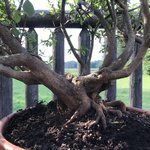I have found that shaking/scraping as much of the garden soil out of the roots as is easily feasible them potting into my usual bonsai mix works here. I don't use kanuma. My preferred mix is aged 70 pine bark + 30 coarse sand and azaleas seem to be Ok in that.
I generally reduce roots substantially at collection to fit into smallish pots but I don't think that's critical to transplant survival.
Trunks are cut back substantially at collection. Like you have, I completely remove entire trunks that obviously do not fit any possible design. After that I chop over long trunks and branches. Sometimes that means collected azaleas lose all the foliage but that does not seem to affect survival. They just flush out masses of new buds from the remaining bare wood.
While retaining foliage is probably preferrable, I know that harder chops are possible with azalea.
My collected azaleas then go into semi shade and are watered regularly for the first year until I can see they will survive the transplant.
Garden soil in pots is never a great idea which is why I try to remove a much as possible from the roots before potting up. But, given the slightly deeper terracotta pot I would say the garden soil/potting soil mix will probably be OK for the first year or so as the wettest spots will be way down away from most of the azalea roots and the terracotta will help dry the soil anyway. You should definitely monitor soil moisture and change watering schedules to suit the soil, pot and plant though instead of just watering this when you do all the others.
It is not possible to give accurate styling advice from internet pictures as I can't accurately see which direction many of the branches and trunks are heading.
I can see some big picture factors though:
Main trunk leans strongly left but several strong branches growing right contradict the main flow - remove or reduce the strong right side. The biggest branch seems a bit too thick to remove completely so shorten and develop a small foliage mass low down to the right.
I would consider trying to emphasise the flow to the left with strong branches and masses of foliage out that side. see virt for possible idea.

I can't make out where the main trunk heads - forward or backward in there or which branches are well placed on the trunk to be used in this design.
You will definitely need to ground truth this possible plan to confirm it will work with the trunk and the branches you have.
Apart from removing some redundant trunks I would NOT be putting this into action now. Let the tree recover and adjust to the pot for at least a year. Sometimes they seem to recover slowly and I've had some that took more than 2 years to get going after collection.
I do like the size and flow of the main trunk. Hope this encourages others to look out for advanced garden azaleas. I know there are a lot down here that get scrapped every year as homes are modified and gardens renovated. Keep eyes peeled for building demolitions, house extensions, garden renovations, especially soon after an older home is sold and reach out to the owner/developer/builder to get hold of suitable garden plants.
Look forward to updates as things happen.
Good luck

















